Deck 5: Stereochemistry
Question
Question
Question
Question
Question
Question
Question
Question
Question
Question
Question
Question
Question
Question
Question
Question
Question
Question
Question
Question
Question

Unlock Deck
Sign up to unlock the cards in this deck!
Unlock Deck
Unlock Deck
1/21
Play
Full screen (f)
Deck 5: Stereochemistry
1
Which of the following is the highest priority in the Cahn-Ingold-Prelog system of prioritizing groups for R/S nomenclature? 
A) Propyl group
B) Methyl group
C) Bromine
D) Chlorine

A) Propyl group
B) Methyl group
C) Bromine
D) Chlorine
Bromine
2
Using the priorities assigned to carbon 2, what is the stereochemical designation of carbon 2? 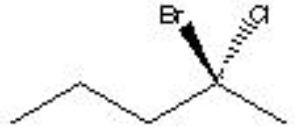
A) R
B) S
C) neither

A) R
B) S
C) neither
S
3
What is the stereochemical designation of carbon 2? 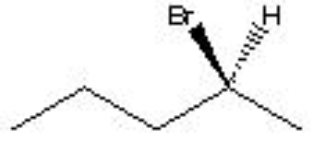
A) R
B) S
C) neither

A) R
B) S
C) neither
S
4
What is the stereochemical designation of carbon 2? 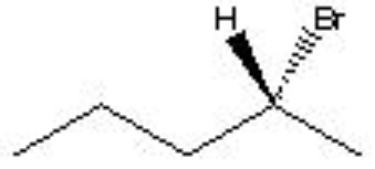
A) R
B) S
C) neither

A) R
B) S
C) neither

Unlock Deck
Unlock for access to all 21 flashcards in this deck.
Unlock Deck
k this deck
5
What is the stereochemical designation of the following molecule? (The roman numerals, I-IV are just used to indicate the different attachments NOT to designate priority). 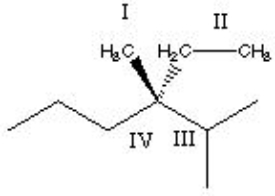
A) R
B) S
C) neither

A) R
B) S
C) neither

Unlock Deck
Unlock for access to all 21 flashcards in this deck.
Unlock Deck
k this deck
6
What is the stereochemical designation of the following molecule? 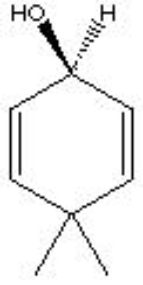
A) R
B) S
C) neither

A) R
B) S
C) neither

Unlock Deck
Unlock for access to all 21 flashcards in this deck.
Unlock Deck
k this deck
7
If a sample of the pure R enantiomer of a molecule has a specific rotation of - 40° and your mixture of that molecule has an observed optical rotation of + 22°, what is the % ee of your sample?
A) 55 % ee R
B) 55 % ee S
C) 18 % ee R
D) .55 % ee R
E) none of the above
A) 55 % ee R
B) 55 % ee S
C) 18 % ee R
D) .55 % ee R
E) none of the above

Unlock Deck
Unlock for access to all 21 flashcards in this deck.
Unlock Deck
k this deck
8
If a sample is 50 % ee of R stereoisomer, what is the % R in the mixture?
A) 50
B) 100
C) 25
D) 75
A) 50
B) 100
C) 25
D) 75

Unlock Deck
Unlock for access to all 21 flashcards in this deck.
Unlock Deck
k this deck
9
If a chemical reaction produces a mixture of 80% R and 20 % S, what is the % ee?
A) 80
B) 60
C) 20
D) 4
A) 80
B) 60
C) 20
D) 4

Unlock Deck
Unlock for access to all 21 flashcards in this deck.
Unlock Deck
k this deck
10
If a sample of the pure R enantiomer of a molecule has a specific rotation of - 40° what is the specific rotation of pure S?
A) -60°
B) +60°
C) -40°
D) +40°
E) cannot be determined
A) -60°
B) +60°
C) -40°
D) +40°
E) cannot be determined

Unlock Deck
Unlock for access to all 21 flashcards in this deck.
Unlock Deck
k this deck
11
If the specific rotation of (R)-2-methylhexan-2-ol is -35°, what is the specific rotation of (S)-hexan-2-ol?
A) -35°
B) +35°
C) it is negative but value cannot be determined
D) it is positive but value cannot be determined
E) it cannot be determined
A) -35°
B) +35°
C) it is negative but value cannot be determined
D) it is positive but value cannot be determined
E) it cannot be determined

Unlock Deck
Unlock for access to all 21 flashcards in this deck.
Unlock Deck
k this deck
12
If a sample of the pure R enantiomer of a molecule has a specific rotation of - 40° and your mixture of that molecule has an 82% ee S, what is the observed specific rotation of your sample?
A) +40°
B) +8.2°
C) +32.8°
D) -48.7°
E) cannot be determined
A) +40°
B) +8.2°
C) +32.8°
D) -48.7°
E) cannot be determined

Unlock Deck
Unlock for access to all 21 flashcards in this deck.
Unlock Deck
k this deck
13
Indicate the relationship of the pair of molecules shown. 
A) same molecules
B) enantiomers
C) diastereomers
D) different molecules
E) constitutional isomers

A) same molecules
B) enantiomers
C) diastereomers
D) different molecules
E) constitutional isomers

Unlock Deck
Unlock for access to all 21 flashcards in this deck.
Unlock Deck
k this deck
14
Indicate the relationship of the pair of molecules shown. 
A) same molecules
B) enantiomers
C) diastereomers
D) different molecules
E) constitutional isomers

A) same molecules
B) enantiomers
C) diastereomers
D) different molecules
E) constitutional isomers

Unlock Deck
Unlock for access to all 21 flashcards in this deck.
Unlock Deck
k this deck
15
Indicate the relationship of the pair of molecules shown. 
A) same molecules
B) enantiomers
C) diastereomers
D) different molecules
E) constitutional isomers

A) same molecules
B) enantiomers
C) diastereomers
D) different molecules
E) constitutional isomers

Unlock Deck
Unlock for access to all 21 flashcards in this deck.
Unlock Deck
k this deck
16
Indicate the relationship of the pair of molecules shown. 
A) same molecules
B) enantiomers
C) diastereomers
D) different molecules
E) constitutional isomers

A) same molecules
B) enantiomers
C) diastereomers
D) different molecules
E) constitutional isomers

Unlock Deck
Unlock for access to all 21 flashcards in this deck.
Unlock Deck
k this deck
17
Indicate the relationship of the pair of molecules shown. 
A) same molecules
B) enantiomers
C) diastereomers
D) different molecules
E) constitutional isomers

A) same molecules
B) enantiomers
C) diastereomers
D) different molecules
E) constitutional isomers

Unlock Deck
Unlock for access to all 21 flashcards in this deck.
Unlock Deck
k this deck
18
Indicate the relationship of the pair of molecules shown. 
A) same molecules
B) enantiomers
C) diastereomers
D) different molecules
E) constitutional isomers

A) same molecules
B) enantiomers
C) diastereomers
D) different molecules
E) constitutional isomers

Unlock Deck
Unlock for access to all 21 flashcards in this deck.
Unlock Deck
k this deck
19
Indicate the relationship of the pair of molecules shown. 
A) same molecules
B) enantiomers
C) diastereomers
D) different molecules
E) constitutional isomers

A) same molecules
B) enantiomers
C) diastereomers
D) different molecules
E) constitutional isomers

Unlock Deck
Unlock for access to all 21 flashcards in this deck.
Unlock Deck
k this deck
20
Indicate the relationship of the pair of molecules shown. 
A) same molecules
B) enantiomers
C) diastereomers
D) different molecules
E) constitutional isomers

A) same molecules
B) enantiomers
C) diastereomers
D) different molecules
E) constitutional isomers

Unlock Deck
Unlock for access to all 21 flashcards in this deck.
Unlock Deck
k this deck
21
Indicate the relationship of the pair of molecules shown. 
A) same molecules
B) enantiomers
C) diastereomers
D) different molecules
E) constitutional isomers

A) same molecules
B) enantiomers
C) diastereomers
D) different molecules
E) constitutional isomers

Unlock Deck
Unlock for access to all 21 flashcards in this deck.
Unlock Deck
k this deck



